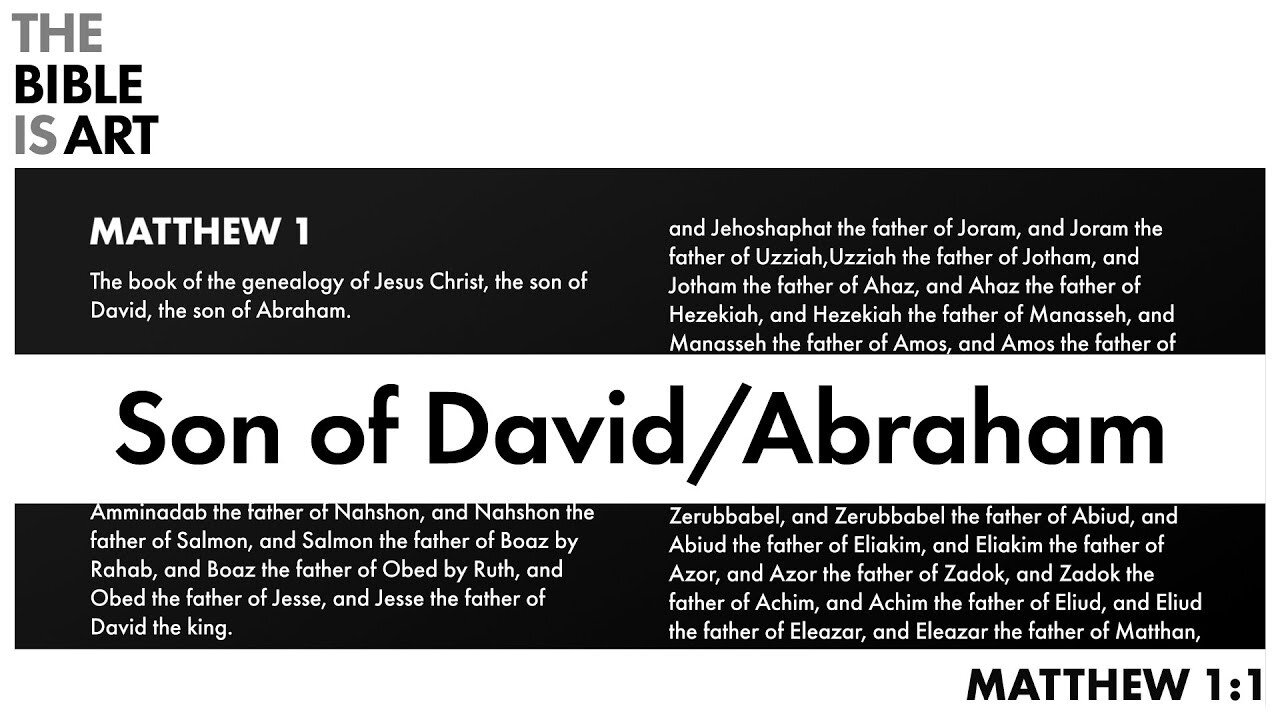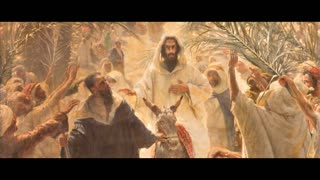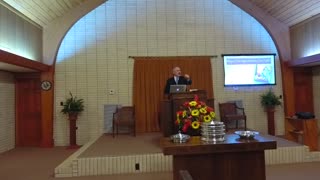Premium Only Content

The Subtlety of the Son of David and Son of Abraham
In this video I explore what Matthew means in Matthew 1:1 when he says that Jesus is the "son of David" and the "son of Abraham."
The Bible is the greatest work of literary genius. And The Bible is Art is a YouTube Channel devoted to explaining this literary art in all its sophistication, elegance, and design.
Patreon: https://www.patreon.com/thebibleisart
website: https://www.thebibleisart.com
email: thisdivineart@gmail.com
twitter: @johnbhiggins
music: Kai Engel, "Coelum" (https://www.kai-engel.com)
| How to Learn to Read the Bible as Literary Art |
Reading Biblical Narrative: An Introductory Guide (https://amzn.to/30LzaRa)
Narrative Art in the Bible (https://amzn.to/30RVGIb)
The Art of Biblical Narrative (https://amzn.to/3aDrIfk)
Old Testament Narrative: A Guide to Interpretation (https://amzn.to/38rcE2C)
The Poetics of Biblical Narrative (https://amzn.to/2Gh4cqE)
| Literary Structure |
Literary Structure of the Old Testament (https://amzn.to/30Jdm8X)
Style And Structure In Biblical Hebrew Narrative (https://amzn.to/2RDTTlQ)
| Genesis |
Creation: The Story of Beginnings - Grossman (https://amzn.to/2GlPwq9)
Abram to Abraham: A Literary Analysis of the Abraham Narrative - Grossman (https://amzn.to/2v7id7Z)
Narrative Art in Genesis - Fokkelman (https://amzn.to/2ulmd4t)
A Commentary on the Book of Genesis (Part I) - Cassuto (https://amzn.to/2NOAhdt)
A Commentary on the Book of Genesis (Part II) - Cassuto (https://amzn.to/2Gcuk6d)
Genesis: A Commentary - Waltke (https://amzn.to/2vaBvt7)
The Gospel of Genesis: Studies in Protology and Eschatology - Gage (https://amzn.to/2RGjRFo)
Abraham and All the Families of the Earth: A Commentary on the Book of Genesis 12-50 - Janzen (https://amzn.to/2TVyCqJ)
Genesis 1-15, Volume 1 - Wenham (https://amzn.to/2TQnYRO)
Genesis 16-50, Volume 2 - Wenham (https://amzn.to/3aDY21J)
| Transcription |
We often think that genealogies are lists of names, just a collection of people without any purpose or perspective. But nothing could be further from the truth.
In Jesus’ family tree, there are hundreds, if not thousands of names missing. So when Matthew composed this family tree he very precisely chooses whom he would include and exclude, and he excludes almost everybody in the family. And when figure out why he includes the people he did we will understand the purpose of the genealogy.
First, notice how he gives the high points right at the beginning: son of David, Son of Abraham.
Now remember, this genealogy is not meant to tell us about the people listed but to tell us about Jesus, to characterize him. The character of his family is the character of him and his kingdom.
So Jesus is the son David. That is, Jesus is in the Kingly line. And he is the son of Abraham, that is he is the inheritor of that great covenant God made with Abraham.
But think about those statements again, son of David, son of Abraham. Matthew is doing something subtle. He’s not just saying that Jesus is in the family of David and Abraham but that he is their son. So who was the son of David? Solomon. And who was the son of Abraham? Issac.
So Jesus is not only like Abraham and David, he’s also like Isaac and Solomon. So how is Jesus like these figures. Well, Isaac’s great act was his self sacrifice and this will be Jesus is great act. So, from the first sentence of Matthew’s gospel there is a hint of its climax.
But what about Solomon? Solomon was known for two things, his wisdom and his temple. And it’s interesting that later in Matthew’s gospel Jesus is said to be greater than Solomon and greater than his temple.
Furthermore, we saw last week that Matthew structured his whole book around chapter 13, eight parables that explain Jesus and his kingdom. And what’s fascinating is that in chapter 13 when he’s explaining to the disciples why he’s speaking in parables he describes the parables with the same word that opens up the book of Proverbs. In Proverbs chapter 1 verse one says “the Proverbs of Solomon”, the same word as parables in Matthew. So in a sense, in the middle of Matthew's gospel are the proverbs, the wisdom of the new and greater Solomon, Jesus.
From the first verse of Matthew's gospel we learned that this Jesus is a wise temple builder who will sacrifice himself. But what we don’t know is what his temple will be like or what his sacrifice or what his wisdom will be like because it’s not going to be like the old temple or the old sacrifice. But to understand the character of this new temple and wisdom and sacrifice we will have to read the rest of Matthew’s work, the rest of his great literary art.
-
 1:03
1:03
Vanguardia
3 years agoAbraham Chía
3.08K -
 1:22
1:22
Vanguardia
3 years agoAbraham Chía fue asesinado
3.09K -
 1:09
1:09
PamphletsToInspireA1
3 years agoThe Meaning of Son of David
6 -
 1:05:08
1:05:08
Union Hill Church of Christ
3 years agoThe Call of Abraham
11 -
 40:42
40:42
SouthernbelleReacts
1 day ago😂 American Pie (1999) Reaction | Iconic Teen Comedy, High School Chaos & 90s Nostalgia 🥧
361 -
 24:06
24:06
True Crime | Unsolved Cases | Mysterious Stories
5 days ago $0.11 earnedShe Traveled Alone… and Never Came Back – 5 Mysterious Unsolved Cases (Part 6)
1271 -
 27:23
27:23
Clickbait Wasteland
13 hours agoAsking New Yorkers Who They Support For Mayor: Staten Island
491 -
 16:58
16:58
World2Briggs
21 hours agoThe California Rant: Point Blank With No Fluff or BS. California Gold?
198 -
 17:49
17:49
Chris Harden
1 day ago $0.01 earnedThe Glass Capital That Shattered | The Decline of Streator, Illinois
8 -
 51:15
51:15
JohnXSantos
3 days agoClothing Brand Manufacturers + Winners
191